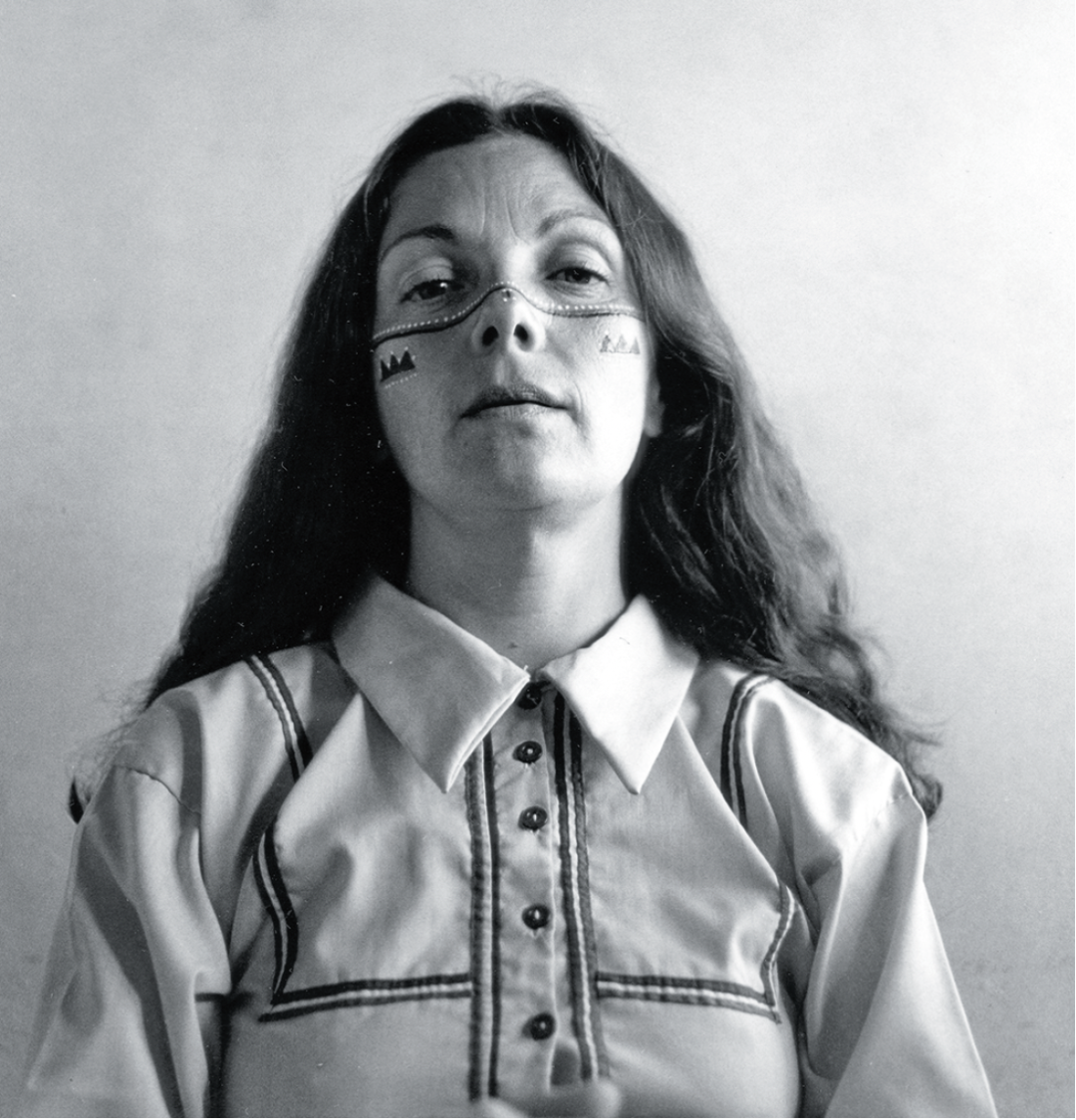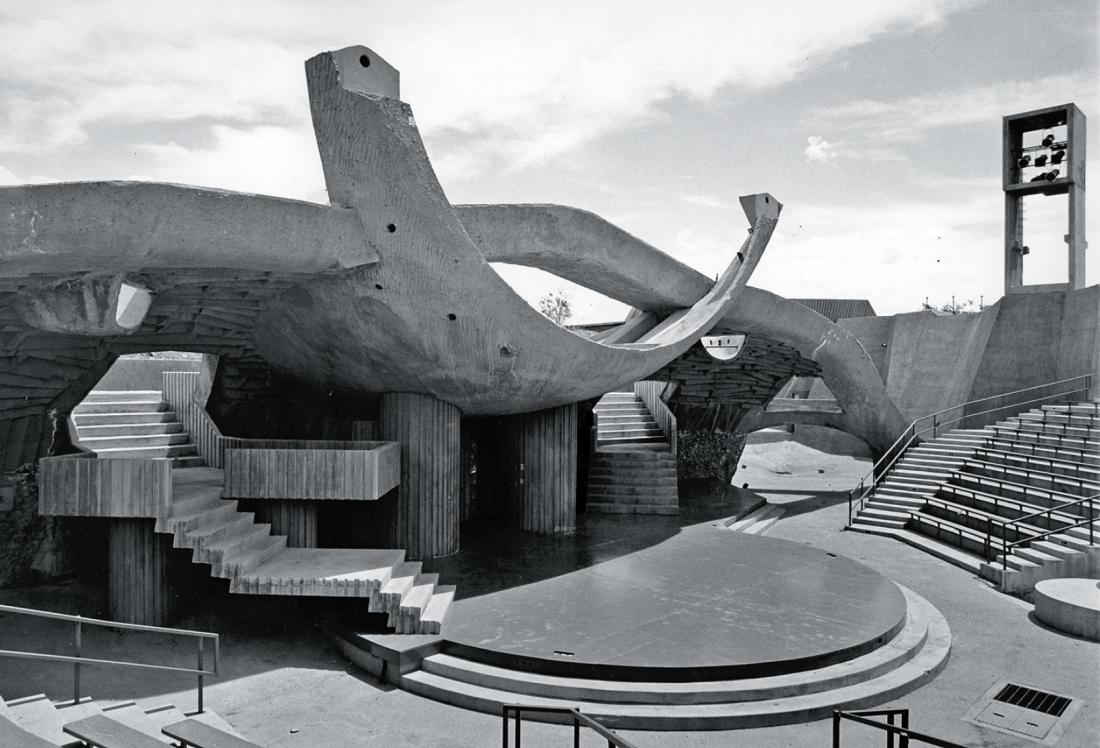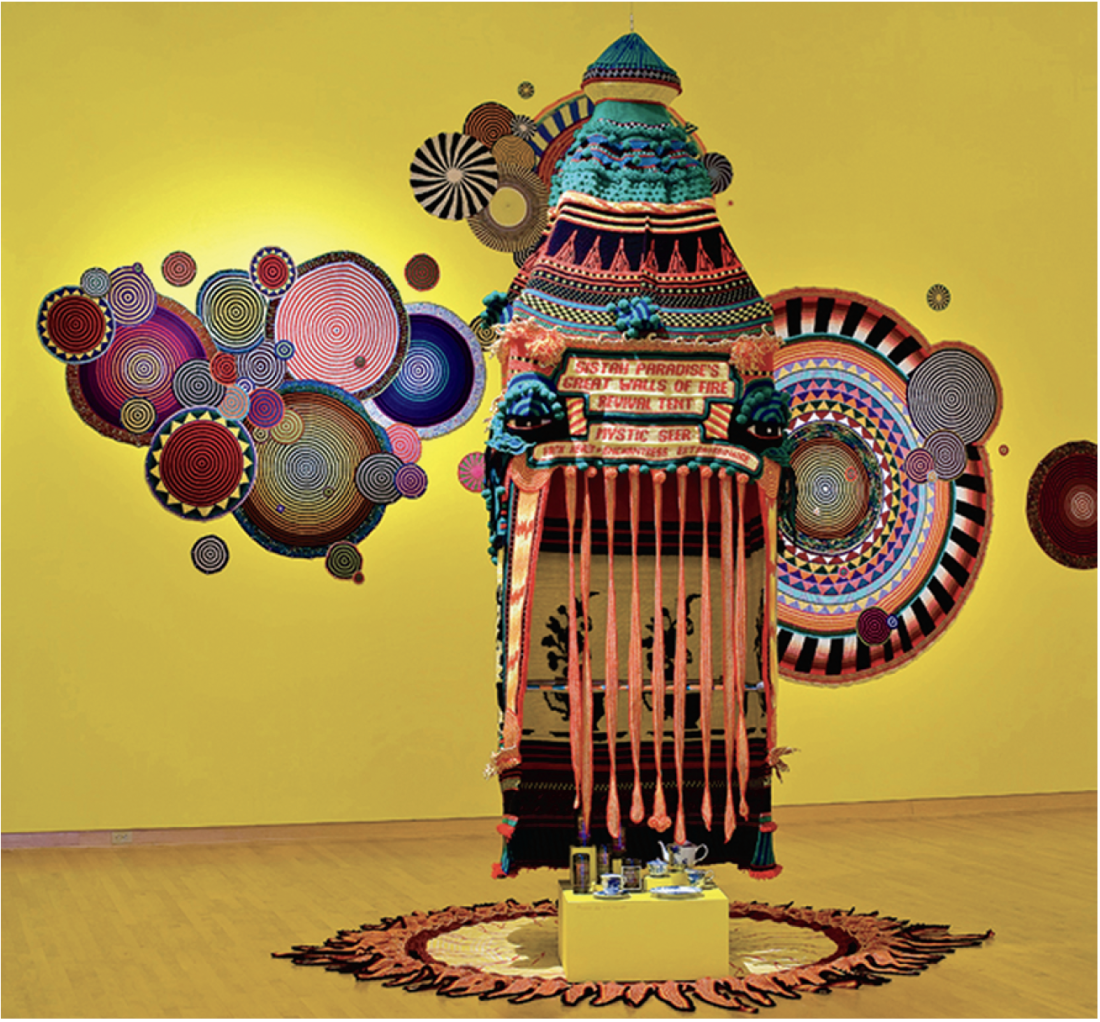SITElines 2016: New Perspectives on Art of the Americas
The metaphorical entry point of “much wider than a line,” the second iteration of the SITE Santa Fe biennial under the vision of Director Irene Hofmann, is The Paolo Soleri Amphitheater, in the form of a large-scale black and white photograph. Completed in 1970 using Native American design principles to showcase a variety of performances, including Native American theatre, this free-form concrete tour de force is now abandoned and facing demolition. It is situated on Native land, alongside a Native school originally used to assimilate indigenous children from the southwestern United States. As a site of both collaborative and combative cross-cultural practices, it casts its hopes and shadows over the complexities of this ambitious exhibition.
Amidst the diverse curatorial agendas of Rocío Aranda-Alvarado, Kathleen Ash-Milby, Pip Day, Pablo León de la Barra and Kiki Mazzucchelli, and working with 35 artists from across the Americas, moments of cross-cultural connectivity are gathered in order to pitch several geopolitical perspectives into dialogue.

Graciela Iturbide, Self Portrait with the Seri Indians, Sonoran Desert, Mexico, 1979, photograph. Image courtesy the artist. and SITE Santa Fe.
Among them are a number of Brazilian works, and spiritually leading them is the late Lina Bo Bardi, whose archiving collections valorize the vernacular. As an Italian Modernist who had great respect for the grassroots Brazilian traditions of her adopted country—ones that emerged from necessity and survival—she was the first to engage with the art of the local working classes and elevate it to the status of high culture. She pursued this both as an architect and furniture designer inspired by folk art and as a founder of the São Paulo Museum of Art (1947) and the Solar do Unhão craft museum of Bahia (1959), where she favoured Brazilian popular culture. This visionary form of creative democracy identified those who would produce art which had an impact on social change.
From today’s Bahia, artist Jonathas de Andrade’s A Study of Race and Class: Bahia><Santa Fe, 2016, a commissioned work for SITE inspired by a 1951 UNESCO inquiry into race and class in Brazil, questions and reformulates this inquiry in a photo essay set in Santa Fe that treads forebodingly around our collective investment in visual discrimination. In his artist’s talk, de Andrade sited Gilberto Freyre’s 1930 anthropological treatise, “The Masters and the Slaves,” as a preoccupation, another controversial historical inquiry wherein the author noted, “Every Brazilian, even the lightskinned fair-haired one, carries… the shadow or at least the birthmark of the aborigine or the negro, in our affections, our excessive mimicry, our Catholicism which so delights the senses, our music, our gait, our speech, our cradle songs, in everything that is a sincere expression of our lives, we almost all of us bear the mark of that influence.”
Close by, the mid-20th-century photographs of late French photojournalist and Afro-Brazilian ethnographer Pierre Verger and the 1978 photographic documentations of native life and ritual in Mexico by Mexican artist Graciela Iturbide further attempt to disrupt the “anthropologist’s gaze” by endeavouring to enter into the experience of the Other and be one with their photographic subjects.

Paolo Soleri Amphitheater, Santa Fe, NM. Courtesy SITE Santa Fe.
American Xenobia Bailey’s Sistah Paradise’s Revival Tent, 1999– present, a hand-crocheted site for mystic seers, hacks into an African American spiritual tradition and cosmology that is rarely referenced in our stereotypes. When introducing this work, the artist talked about what she learned in the kitchens of her caretakers as a girl: the secrets of everything from the best Gumbo recipe, to reading future events in the stars, to the African diasporic foraging, healing and survival skills that allowed the Maroons who escaped plantations in the 20th century to successfully move among the swamps and trees. All of this is invaluable oral intelligence that is never taught in Western schools but that the West is seeking in our current ecological crisis. Perpetuating this knowledge and offering it for public consumption in work that references the domestic but is not craft or folklore, points to an emerging space where what has been “secret women’s wisdom” can now exteriorize as an art form to propose fresh dialogues to an art market that has never included it, and a larger cultural tradition that has worked to suppress it.
Memorable Indigenous works explore other perspectives of uniting across lines. Canadian Maria Hupfield’s felt jingle gloves and boots in It Is Never Just About Sustenance or Pleasure, 2016, and Jeffrey Gibson’s ceremonial jingle robe in Like A Hammer, 2016, merge ritual with wearable pieces that make differing Indigenous spiritual principles tangible and sharable in secular daily life objects. Colombian botanist Abel Rodríguez’s Amazonian medicinal plant taxonomy drawings, The Cycle of the Maloca Plants, 2009, scientifically depict the Indigenous knowledge that he has preserved despite displacement and Western education. Zacharias Kunuk’s Inuit worldview in his film, Atanarjuat: The Fast Runner, 2001, talks back to the intellectualized notions of the Anthropocene from the lived experience of those in the far north whose survival is intimately tied to the earth’s cycles and to their relationships with each other.

Xenobia Bailey, Sistah Paradise’s Great Wall of Fire Revival Tent, 1993–ongoing, cotton and acrylic yarn, metal frame, electrical tape, shells. Image courtesy the artist. and SITE Santa Fe.
Raven Chacon’s “Native- American Composers Apprentice Project,” 2004–present, is recordings by Navajo teens who take his crash course in classical composition, and conceptualizes what is felt and known by young people of their traditions, as if through a musical excavation of their genetic cellular memories. Pink Lightning, an extraordinary piece written by a 13-year-old girl, is a powerfully moving aural depiction of sunset over sacred mountains that everyone can participate in feeling.
The many forms of experimental citizenship and relationship in this exhibition raise consciousness about the origins of borders and offer models for new ways of being. We are reminded that the economic, political and social mores of capitalism and post-colonialism can be undone and reconfigured in the art space, where life’s perceptions succumb to the non-logical, the non-linear and the emotional. Raven Chacon said, “Activists have a solution. Artists complicate things so we can see them better,” and “much wider than a line” bears this out. ❚
“SITElines 2016: much wider than a line” is on exhibition at SITE Santa Fe, New Mexico, from July 16, 2016 to January 8, 2017.
Caia Hagel is a freelance art writer, editor-in-chief of SOFA magazine (<sofa-universe.com>) and co-author of Girl Positive (<girlpositive.ca>).

